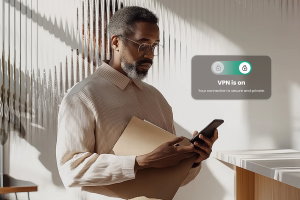As we honor Veterans Day, it’s crucial to recognize not only the sacrifices made by those who served but also the unique cybersecurity challenges they face in today’s digital age. Veterans, with their deep ties to sensitive military information and benefits, are increasingly being targeted by cybercriminals seeking to exploit their personal data. Seven in 10 military vets and active-duty service members have been a victim of at least one digital crime.
From phishing scams impersonating official VA communications to the risk of military identity theft, veterans encounter specific threats that require tailored cybersecurity awareness and precautions. By taking proactive steps, veterans can implement strong security practices to better protect their identities and enjoy a safer online experience.
Understanding the Risks
Veterans possess a wealth of sensitive information tied to their military service. This includes not only Social Security numbers, medical records, and details about deployments and benefits, but also personal histories that can include addresses, family information, and even details about combat experiences. Such comprehensive information is highly valuable to cybercriminals for various malicious activities, including identity theft and financial fraud.
Cybercriminals can exploit this data to impersonate veterans, gain unauthorized access to financial accounts, file false claims for VA benefits, or sell the information on the dark web. The repercussions of such breaches extend beyond financial loss, impacting veterans’ reputations, access to essential services, and overall peace of mind. Safeguarding this sensitive data is critical to ensuring veterans’ security and well-being in the digital age.
Common Threats Faced by Veterans
One of the primary threats that veterans encounter is phishing scams. These scams often impersonate official communications from the Department of Veterans Affairs (VA) or other military organizations. Cybercriminals use deceptive emails, text messages, or phone calls to trick veterans into revealing personal information or clicking malicious links that can compromise their devices.
Another prevalent danger is military identity theft, where criminals use stolen or fabricated military credentials to access benefits, obtain loans, or commit fraud in the veteran’s name. This type of identity theft can be particularly devastating, affecting not only financial stability but also the veteran’s reputation and access to crucial services.
Cybersecurity Awareness and Security Tips
In 2023, military consumers filed more than 93,000 fraud complaints, with imposter scams alone accounting for 42,766 cases, resulting in reported losses exceeding $178 million. To combat these threats, veterans must be equipped with robust cybersecurity awareness and practices:
- Social Media Caution: Avoid sharing specific details about military service, deployments, or personal schedules on social media. Cybercriminals can use this information to impersonate you or guess security questions for account access. Adjust privacy settings on social media platforms to restrict who can view your posts and personal information. Social Privacy Manager can help you adjust more than 100 privacy settings across your social media accounts in just a few clicks.
- Recognizing Phishing Attempts: Always verify the authenticity of emails or messages claiming to be from the VA or other military organizations before clicking on links or providing information. Official organizations typically do not request sensitive information via email or text.
- Use Multi-Factor Authentication: Secure online accounts by enabling multi-factor authentication (MFA) whenever possible. MFA adds an extra layer of security by requiring a second form of verification, such as a code sent to your phone or email, in addition to your password.
- Embrace Password Complexity: Create passwords that are at least 12 characters long and include a mix of uppercase letters, lowercase letters, numbers, and special characters. Avoid using easily guessable information like birthdates or common words. Use a reputable password manager to generate and store complex passwords securely.
- Regularly Monitoring Financial Accounts: Keep a close eye on bank statements, credit reports, and VA benefits statements for any unauthorized activity. Early detection can minimize the damage caused by identity theft. Setting up credit monitoring can also help you keep an eye out for unusual activity on your accounts.
- Automatic Updates: Enable automatic updates for operating systems, software applications, and antivirus programs to ensure you have the latest security patches and protections against vulnerabilities.
- Educating Family Members: Inform family members about the importance of cybersecurity practices, including recognizing phishing attempts and safeguarding personal information. Encourage family members to review and adjust privacy settings on their own social media accounts to limit exposure of personal information that could indirectly impact your security.
- Consider Identity Theft Protection: For increased peace of mind, consider investing in a McAfee+ Family plan which protects up to 6 members with identity and privacy protection, including 24/7 monitoring of your personal info with alerts if something requires your attention and award-winning antivirus security for all your devices.
What to do if you may have been exposed
If you think you have been the victim of identity theft, immediately take steps to protect yourself and your family:
- Place a Fraud Alert and Get Your Credit Reports: Contact a major credit bureau (Equifax, Experian, or TransUnion) to place a fraud alert on your credit report. This alert notifies creditors to take extra steps to verify your identity before opening new accounts in your name. Request and review your credit reports from all three bureaus to check for any unauthorized accounts or transactions.
- Notify Your Commanding Officer: If you are an active-duty service member, inform your commanding officer immediately. This step is crucial to prevent unexpected calls or actions related to fraudulent debts or activities that could impact your military status or security clearance. Your commanding officer can provide guidance and support in handling the situation within military protocols.
- File a Police Report: Contact your local law enforcement agency to file a report about the identity theft. Provide them with a copy of your Identity Theft Report from IdentityTheft.gov. A police report can support your claims of identity theft and may be required by creditors or financial institutions as part of the recovery process.
- Monitor Your Accounts: Regularly monitor all financial accounts, including bank accounts, credit cards, and investment accounts, for any suspicious activity. Report any unauthorized transactions immediately to the respective financial institution.
- Consider Placing a Credit Freeze: A credit freeze restricts access to your credit report, making it more difficult for identity thieves to open new accounts in your name. Contact each of the credit bureaus to request a credit freeze. You can temporarily lift or permanently remove the freeze when needed.
- Report identity theft to the FTC: Visit identitytheft.gov, the Federal Trade Commission’s dedicated website for identity theft victims. Follow the step-by-step instructions to report the theft and provide as many details as possible about the fraudulent activity. IdentityTheft.gov will help you create an Identity Theft Report, which is essential for disputing fraudulent charges and repairing your credit.
- Seek Support and Counseling: Identity theft can be a stressful and emotionally draining experience. Consider seeking support from military support services, such as Military OneSource, which offers resources and counseling to service members and their families facing financial challenges and identity theft.
As veterans continue to navigate the complexities of modern life, safeguarding their personal information online is paramount. By staying informed about cybersecurity best practices and leveraging available resources, veterans can significantly reduce their risk of falling victim to cyber threats.













